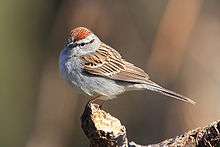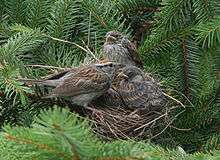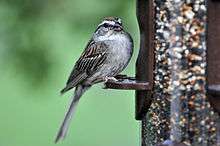Chipping sparrow
| Chipping sparrow | |
|---|---|
 | |
| Adult in breeding plumage | |
| | |
| Scientific classification | |
| Kingdom: | Animalia |
| Phylum: | Chordata |
| Class: | Aves |
| Subclass: | Neornithes |
| Infraclass: | Neognathae |
| Superorder: | Neoaves |
| Order: | Passeriformes |
| Suborder: | Passeri |
| Infraorder: | Passerida |
| Superfamily: | Passeroidea |
| Family: | Emberizidae |
| Genus: | Spizella |
| Species: | S. passerina |
| Binomial name | |
| Spizella passerina (Bechstein, 1798) | |
| Synonyms | |
|
Spizella socialis | |
The chipping sparrow (Spizella passerina) is a species of American sparrow, a passerine bird in the family Emberizidae. It is widespread, fairly tame, and common across most of its North American range. There are two subspecies, the eastern chipping sparrow and the western chipping sparrow. This bird is a partial migrant with northerly populations flying southwards in the fall to overwinter in Mexico and the southern United States, and flying northward again in spring. It molts twice a year. In its breeding plumage it has orangish-rust upper parts, gray head and underparts and a distinctive reddish cap. In non-breeding plumage, the cap is brown and the facial markings are less distinct. The song is a trill and the bird has a piercing flight call that can be heard while it is migrating at night.
In the winter, chipping sparrows are gregarious and form flocks, sometimes associating with other bird species. They mostly forage on the ground for seeds and other food items, as well as clambering on plants and trees, feeding on buds and small arthropods. In the west of their range they breed mainly in coniferous forests, but in the east, they choose woodland, farmland, parks and gardens. Breeding starts in late April and May and the nest is often built in a tree.
Description

Throughout the year, adults are gray below and an orangish-rust color above. Adults in alternate (breeding) plumage have a reddish cap, a nearly white supercilium, and a black trans-ocular line (running through the eye). Adults in basic (nonbreeding) plumage are less prominently marked, with a brownish cap, a dusky eyebrow, and a dark eye-line.
Juvenile chipping sparrows are prominently streaked below. Like non-breeding adults, they show a dark eye-line, extending both in front of and behind the eye. The brownish cap and dusky eyebrow are variable but generally obscure in juveniles.
Vocalizations
 |
Four songs of the chipping sparrow
|
| Problems playing this file? See media help. | |
The song is a trill that varies considerably among birds within any particular region. Two broad classes of variation in the song of the chipping sparrow are the fast trill and the slow trill. Individual elements in the fast trill are run together about twice as fast as in the slow trill; the fast trill sounds like a buzz or like someone snoring, whereas the slow trill sounds like rapid finger-tapping. Individual elements in the trill are very similar to a high pitch chi chi chi call.
The flight call of the chipping sparrow is heard year-round. Its flight call is piercing and pure-tone, lasting about 50 milliseconds. It starts out around 9 kHz, then falls to 7 kHz, then rises again to 9 kHz. The flight call may be transliterated as seen? Chipping sparrows migrate by night, and their flight calls are a characteristic sound of the night sky in spring and fall in the United States. In the southern Rockies and eastern Great Plains, the chipping sparrow appears to be the most common nocturnal migrant, judged by the number of flight calls detected per hour. On typical nights in August in this region, chipping sparrows may be heard at a rate of 15 flight calls per hour. On better-than-average nights, chipping sparrows occur at a rate of 60 flight calls per hour, and on exceptional nights chipping sparrows' flight calls are heard more than 200 times per hour.
Systematics
Chipping sparrows vary across their extensive North American range. There is minor geographic variation in appearance, and there is significant geographic variation in behavior. Ornithologists often divide the chipping sparrow into two major groups: the eastern chipping sparrow and the western chipping sparrow. However, there is additional plumage and behavioral variation within the western group.
At least two subspecies of chipping sparrows occur in western North America. The widespread Spizella passerina arizonae is associated with mountains and arid habitats of the western interior. A Pacific slope population constitutes subspecies S. p. stridula. Although these two races are both western, and are often lumped together as the western chipping sparrow, they do not necessarily form a single entity that stands apart from the eastern chipping sparrow (S. p. passerina).
The chipping sparrow is part of the family Emberizidae, and is not closely related to the Old World sparrows of the family Passeridae.[2]
Ecology

In eastern North America, chipping sparrows breed in woodlands, farmlands, and suburban and urban districts. In western North America, the chipping sparrow prefers conifer forests for breeding. The chipping sparrow is partially migratory, with almost all mid-latitude and high-latitude breeders withdrawing in winter to the southern United States and Mexico. On the wintering grounds and during migration, chipping sparrows are gregarious, forming tight flocks with other chipping sparrows or loose assemblages with other species such as eastern bluebirds and pine warblers.
Throughout the year, chipping sparrows forage on the ground, often in loose flocks. Their diet consists mainly of seeds and crumbs of mostly any food, especially those fallen on the ground. Chipping sparrows frequently forage directly from forbs and grasses, too. At any time of the year, especially, in spring, chipping sparrows may be seen in trees, even up in the canopy, where they forage on fresh buds and glean for arboreal arthropods.
Although they are wary, chipping sparrows often allow close approach. A quiet observer can often get to within 50–100 ft (15–30 m) of one or more chipping sparrows feeding on the ground. When spooked, chipping sparrows fly a short distance to the nearest tree or fencerow.
In early spring, the first migrants return from their wintering grounds in March, but the bulk of migrants arrives throughout April. Males set up territories right away, and their trilled songs make them conspicuous. Breeding begins as early as April, but again, most nesting activity occurs from late April to early May onwards.[3][4]
Molt in the chipping sparrow follows the "Complex Alternate Strategy" as usual for American sparrows. It consequently has two molts per year as adults and three molts in their first year of life, also called their first plumage-cycle. The chipping sparrow's two adult molts occur in late summer and late winter.
Although this bird's original habitat was probably coniferous forest, especially the eastern subspecies has adapted well to the changes brought about by increased human population in its range.
References
- ↑ BirdLife International (2012). "Spizella passerina". IUCN Red List of Threatened Species. Version 2013.2. International Union for Conservation of Nature. Retrieved 26 November 2013.
- ↑ Allende, Luis M.; Rubio, Isabel; Ruíz-del-Valle, Valentin; Guillén, Jesus; Martínez-Laso, Jorge; Lowy, Ernesto; Varela, Pilar; Zamora, Jorge; Arnaiz-Villena, Antonio (2001). "The Old World sparrows (genus Passer) phylogeography and their relative abundance of nuclear mtDNA pseudogenes" (PDF). Journal of Molecular Evolution. 53 (2): 144–154. doi:10.1007/s002390010202. PMID 11479685. Archived from the original (PDF) on 21 July 2011.
- ↑ Henninger, W.F. (1906). "A preliminary list of the birds of Seneca County, Ohio" (PDF). Wilson Bulletin. 18 (2): 47–60.
- ↑ Ohio Ornithological Society (2004): Annotated Ohio state checklist Archived July 18, 2004, at the Wayback Machine..
External links
| Wikimedia Commons has media related to the chipping sparrow. |
| Wikispecies has information related to: Spizella passerina |
- Chipping sparrow – Spizella passerina – USGS Patuxent Bird Identification InfoCenter
- Chipping sparrow species account – Cornell Laboratory of Ornithology
- "Chipping sparrow media". Internet Bird Collection.
- Chipping sparrow photo gallery at VIREO (Drexel University)
- Interactive range map of Spizella passerina at IUCN Red List maps
